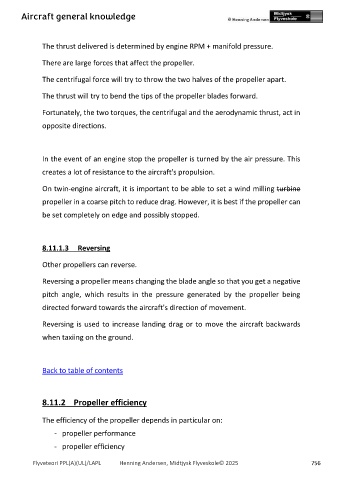Page 756 - PPL-engelsk 2025
P. 756
Aircraft general knowledge
The thrust delivered is determined by engine RPM + manifold pressure.
There are large forces that affect the propeller.
The centrifugal force will try to throw the two halves of the propeller apart.
The thrust will try to bend the tips of the propeller blades forward.
Fortunately, the two torques, the centrifugal and the aerodynamic thrust, act in
opposite directions.
In the event of an engine stop the propeller is turned by the air pressure. This
creates a lot of resistance to the aircraft's propulsion.
On twin-engine aircraft, it is important to be able to set a wind milling turbine
propeller in a coarse pitch to reduce drag. However, it is best if the propeller can
be set completely on edge and possibly stopped.
8.11.1.3 Reversing
Other propellers can reverse.
Reversing a propeller means changing the blade angle so that you get a negative
pitch angle, which results in the pressure generated by the propeller being
directed forward towards the aircraft's direction of movement.
Reversing is used to increase landing drag or to move the aircraft backwards
when taxiing on the ground.
Back to table of contents
8.11.2 Propeller efficiency
The efficiency of the propeller depends in particular on:
- propeller performance
- propeller efficiency
Flyveteori PPL(A)(UL)/LAPL Henning Andersen, Midtjysk Flyveskole© 2025 756

